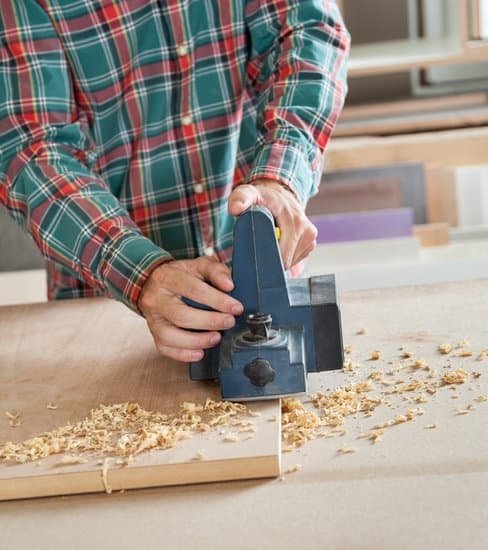A well-organized woodworking tool shelf serves as the backbone of any efficient and productive workshop. Whether you are a seasoned woodworker or just starting out, having easy access to your tools can make all the difference in completing your projects smoothly.
The key to a functional woodworking space lies in the setup of your tool shelf, where every item has its designated spot for quick retrieval. By implementing a woodworking tool shelf, you can streamline your workflow and eliminate the frustration of digging through cluttered drawers or cabinets.
When it comes to setting up a woodworking tool shelf, one of the essential factors to consider is choosing the right location within your workshop. Accessibility, lighting, and proximity to your workbench are crucial elements that can enhance the efficiency of your work area.
Additionally, selecting between wall-mounted and freestanding tool shelves depends on the layout of your space and personal preferences. Understanding these aspects will help you create a set-up that complements your workflow and promotes a smooth working environment.
Whether you opt for a DIY woodworking tool shelf or purchase one from a store, each option has its own set of pros and cons. While building your own shelf allows for customization and cost-saving benefits, store-bought options offer convenience and time efficiency.
Ultimately, the choice between DIY or store-bought depends on your skill level, budget, and time constraints. Whichever route you take, ensuring that the woodworking tool shelf meets essential features such as ample storage capacity, durability, and organization capabilities is paramount for an effective workspace.
Choosing the Right Location for Your Woodworking Tool Shelf
When it comes to setting up a woodworking tool shelf in your workspace, choosing the right location is crucial for efficiency and ease of access. There are several factors to consider when determining where to place your woodworking tool shelf.
Workspace Layout
Consider the layout of your workspace and identify areas that are easily accessible without obstructing other work areas. Placing your woodworking tool shelf in a central location can make it convenient to grab tools quickly while working on various projects.
Visibility and Lighting
Ensure that the location of your woodworking tool shelf provides good visibility of all tools and equipment stored on it. Adequate lighting is also essential to easily locate and retrieve tools when needed. Avoid placing the shelf in dimly lit corners or areas with poor visibility.
Safety Concerns
Take into account safety considerations when deciding on the placement of your woodworking tool shelf. Avoid placing the shelf near potential hazards such as sharp edges, flammable materials, or electrical outlets. Keep a clear path to the shelf to prevent tripping hazards and ensure easy accessibility during emergencies. By considering these factors, you can choose the ideal location for your woodworking tool shelf that enhances productivity and safety in your workspace.
Types of Woodworking Tool Shelves
When it comes to organizing your woodworking tools, choosing the right type of shelf is essential. Two popular options are wall-mounted shelves and freestanding shelves. Wall-mounted shelves are a great space-saving solution, as they keep your tools off the floor and out of the way while still being easily accessible.
They are also ideal for small workshops where floor space is limited. On the other hand, freestanding shelves provide more flexibility in terms of placement and can be easily moved around if needed.
Wall-mounted shelves are typically mounted on a sturdy wall or pegboard using brackets or hooks, while freestanding shelves stand on their own without the need for any additional support. Both types of shelves come in various sizes and configurations, so you can choose one that best suits your needs and workshop layout. Some woodworkers opt to mix and match both wall-mounted and freestanding shelves to create a versatile storage system that maximizes space.
One important factor to consider when deciding between wall-mounted and freestanding woodworking tool shelves is the weight capacity. Wall-mounted shelves should be securely anchored to the wall studs to ensure they can support the weight of your tools without sagging or collapsing.
Freestanding shelves, on the other hand, should have a solid base and durable construction to prevent tipping over when loaded with heavy tools. Ultimately, the choice between wall-mounted and freestanding shelves will depend on your workshop setup, available space, and personal preference.
| Woodworking Tool Shelf Type | Key Feature |
|---|---|
| Wall-Mounted | Space-saving solution |
| Freestanding | Flexibility in placement |
DIY vs Store-Bought Woodworking Tool Shelves
When it comes to setting up a woodworking space, one of the essential elements is having a designated area to store and organize your tools. One crucial decision you’ll need to make is whether to opt for a DIY woodworking tool shelf or purchase a ready-made one from a store. Both options have their own set of pros and cons, which you should consider before making your choice.
Here are some factors to keep in mind when weighing the decision between a DIY woodworking tool shelf and a store-bought one:
- Cost: A DIY woodworking tool shelf can be more cost-effective as you can use materials you already have or purchase affordable supplies. On the other hand, store-bought shelves may offer more features but come with a higher price tag.
- Customization: Building your own woodworking tool shelf allows for complete customization to suit your specific needs and space requirements. However, store-bought options may come in standard sizes and designs that might not perfectly fit your workshop layout.
- Time and Skill Level: DIY projects require time, effort, and some level of woodworking skills. If you’re short on time or lack experience in carpentry, purchasing a pre-made woodworking tool shelf might be the more convenient option.
Ultimately, the decision between DIY and store-bought woodworking tool shelves will depend on your budget, available time, skill level, and personal preference. Whichever option you choose, the key is to create a well-organized space that boosts efficiency and productivity in your woodworking endeavors.
Essential Features of a Functional Woodworking Tool Shelf
A woodworking tool shelf is an essential piece of equipment in any workshop, enabling woodworkers to keep their tools organized, easily accessible, and in top condition. When setting up a woodworking tool shelf, it is important to consider the essential features that will make it functional and efficient. From storage capacity to durability, these features play a crucial role in ensuring that your woodworking tools are well-maintained and readily available when needed.
Storage Capacity
One of the key features to consider when choosing or designing a woodworking tool shelf is its storage capacity. The shelf should be able to accommodate all your essential tools, from hand saws and chisels to power drills and sanders. Consider the size and weight of your tools when determining the appropriate storage capacity for your shelf. Opt for adjustable shelves or modular units that can be customized to fit different types and sizes of tools.
Durability
Durability is another important feature that should not be overlooked when selecting a woodworking tool shelf. The shelf should be sturdy enough to support the weight of your tools without bowing or bending over time. Look for shelves made from high-quality materials such as hardwood or steel that can withstand heavy use and provide long-lasting durability. Additionally, choose shelves with strong joints and connections that can withstand the rigors of daily workshop activities.
Accessibility
In addition to storage capacity and durability, accessibility is also a crucial feature of a functional woodworking tool shelf. The shelf should be designed in a way that allows easy access to all your tools without having to rummage through cluttered items.
Consider incorporating features such as pull-out drawers, rotating trays, or magnetic strips for holding small metal tools like screws and nails. By maximizing accessibility on your woodworking tool shelf, you can save time and effort while working on various projects.
By focusing on these essential features – storage capacity, durability, and accessibility – when setting up your woodworking tool shelf, you can create a well-organized workspace that enhances your productivity and efficiency as a woodworker. Choose or design a shelf that meets these criteria to ensure that your tools are always within reach and well-preserved for years to come.
Organization Tips for Maximizing Space on Your Woodworking Tool Shelf
When it comes to woodworking, having a well-organized tool shelf is essential for efficiency and productivity. Maximizing the space on your woodworking tool shelf can help you easily access your tools, materials, and equipment while working on various projects. Here are some organization tips to help you make the most of your woodworking tool shelf:
- Utilize Vertical Space: Consider installing pegboards or hanging baskets on the walls above your woodworking tool shelf to store smaller tools such as hammers, screwdrivers, and measuring tapes. This will free up space on the shelf itself for larger tools and equipment.
- Group Similar Items Together: Organize your woodworking tools by category or function to make them easier to find when you need them. For example, designate a section of the shelf for saws, another for sanding tools, and so on.
- Invest in Drawer Organizers: If your woodworking tool shelf has drawers, use drawer organizers to keep small items such as nails, screws, drill bits, and other accessories neatly separated and easy to locate.
By implementing these organization tips on your woodworking tool shelf, you can create a more efficient workspace that allows you to focus on your projects without wasting time searching for tools. Remember that a well-organized tool shelf not only improves productivity but also helps maintain the longevity of your tools by keeping them stored safely and securely.
Creative Ways to Customize Your Woodworking Tool Shelf
When it comes to customizing your woodworking tool shelf, there are countless creative ways to add a personal touch and make it truly unique to your style and preferences. One popular way to customize your shelves is by using paint.
Whether you prefer a bold color that stands out in your workshop or a more neutral tone that complements the rest of your decor, a fresh coat of paint can breathe new life into your woodworking tool shelf. Additionally, painting different sections of the shelf in varying colors can help you visually categorize and organize your tools.
Another effective way to customize your woodworking tool shelf is by using labels. Labels can be as simple as adhesive stickers or as intricate as engraved nameplates for each tool slot.
By labeling each section or compartment on your woodworking tool shelf, you can easily identify where each tool belongs, making it quicker and more efficient to find what you need during a project. This simple customization not only adds a professional touch but also helps maintain organization and cleanliness in your workspace.
Furthermore, incorporating tool hooks into your woodworking tool shelf can provide additional storage options and make it easier to access frequently used tools. By installing hooks on the sides or underneath the shelves, you can hang larger tools like hammers or power drills, keeping them within arm’s reach while freeing up valuable shelf space for smaller items. This customization not only maximizes the functionality of your woodworking tool shelf but also adds an element of convenience to your workflow.
| Creative Customization Ideas | Description |
|---|---|
| Paint | Adds color and personality; helps categorize tools visually |
| Labels | Aids in organization; makes it easier to find specific tools quickly |
| Tool Hooks | Provides additional storage; convenient access to frequently used tools |
Maintenance and Care Tips for Keeping Your Woodworking Tool Shelf in Top Condition
Maintaining and caring for your woodworking tool shelf is essential to ensure that it remains in top condition and continues to serve its purpose effectively. Regular upkeep can prevent damage to your tools and keep them easily accessible whenever needed. Here are some tips to help you keep your woodworking tool shelf well-maintained.
Firstly, it is important to regularly clean your woodworking tool shelf to prevent dust and debris from accumulating on the surface. Use a damp cloth or a gentle cleaning solution to wipe down the shelves and remove any dirt or grime. Avoid using harsh chemicals that could potentially damage the wood or finish of the shelf.
In addition to cleaning, regularly inspect your woodworking tool shelf for any signs of wear and tear, such as loose screws or cracks in the wood. Tighten any loose fasteners and repair any damage promptly to prevent further deterioration. This will help prolong the lifespan of your shelf and ensure that it remains sturdy and reliable for storing your tools.
Lastly, consider implementing a maintenance schedule for your woodworking tool shelf, including routine checks and cleanings. By staying proactive with upkeep, you can prevent minor issues from turning into major problems that could affect the functionality of your shelf. Investing time in maintaining your woodworking tool shelf will ultimately save you time and money in the long run by preserving its condition and extending its usability.
Conclusion
Having a well-organized woodworking tool shelf is essential for any woodworker looking to maximize their workspace and productivity. By investing time and effort into setting up an efficient storage system for your tools, you can streamline your workflow, increase efficiency, and reduce the time spent searching for specific items. Whether you choose to go with a DIY shelf or opt for a store-bought one, the benefits of having a designated space for your tools are undeniable.
The right woodworking tool shelf can make a significant difference in how smoothly your projects run. With proper organization and maintenance, you can ensure that your tools are readily accessible when needed, eliminating the frustration of rummaging through cluttered drawers or workbenches. Additionally, by customizing your shelf with personalized touches such as paint, labels, or tool hooks, you can create a space that not only functions well but also reflects your unique style and personality.
In conclusion, taking the time to set up and maintain a woodworking tool shelf tailored to your needs can be a game-changer for any woodworker. By considering factors such as location, type of shelf, essential features, and organization tips, you can create a workspace that promotes efficiency and boosts productivity. So why wait? Start organizing your woodworking tools today and experience the difference it makes in your craft.
Frequently Asked Questions
Where Do You Store Woodworking Tools?
I store my woodworking tools in a dedicated workshop space in my garage. I have a sturdy workbench where I keep smaller hand tools organized in toolboxes and larger power tools stored within arms’ reach for easy access during projects.
What Is the Most Useful Tool for Woodworking?
In my opinion, the most useful tool for woodworking is the versatile table saw. It is essential for making precise cuts, ripping large boards, and creating various joinery techniques. A quality table saw can greatly improve efficiency and accuracy in woodworking projects.
What Are the Basic Woodworking Tools?
The basic woodworking tools that every woodworker should have include a hammer, screwdrivers, tape measure, chisels, handsaws, a block plane, clamps, a level, and a square. These tools are essential for measuring, cutting, shaping, assembling, and finishing wood projects effectively and efficiently.

Hi everyone! I’m a woodworker and blogger, and this is my woodworking blog. In my blog, I share tips and tricks for woodworkers of all skill levels, as well as project ideas that you can try yourself.





